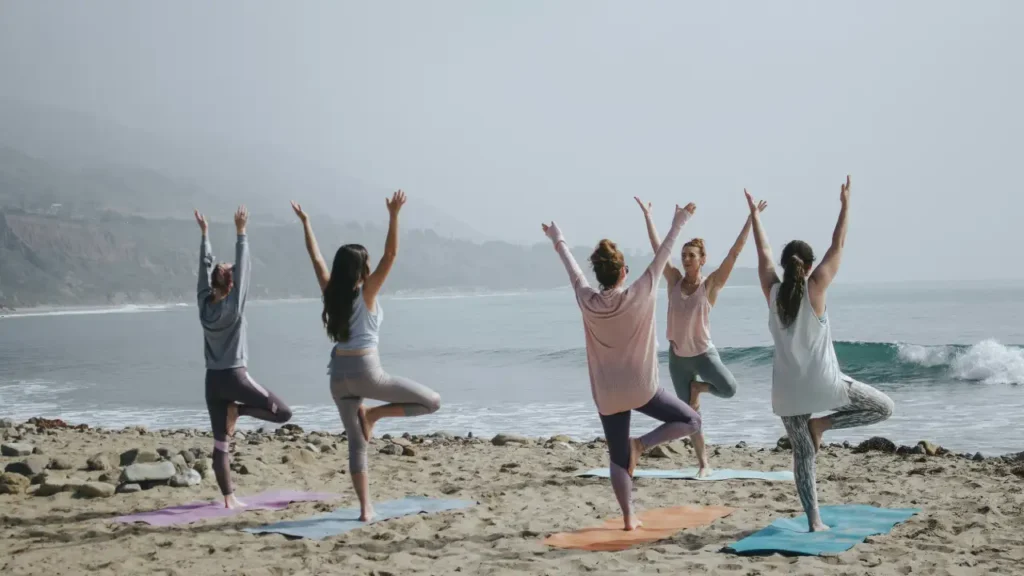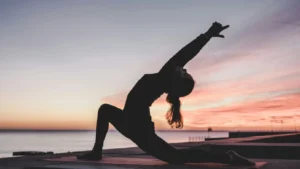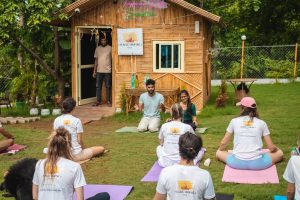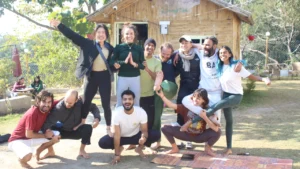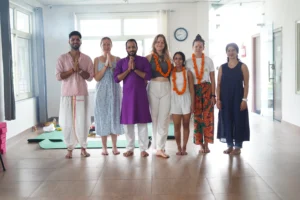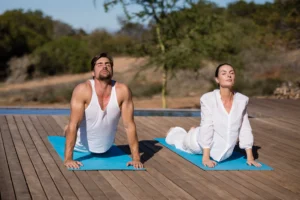Congratulations, aspiring yoga teacher! You’ve just completed your 200-hour Yoga Teacher Training (YTT), a monumental achievement and the solid foundation for your yogic journey. You’ve delved into asana, philosophy, anatomy, and the art of teaching. Now, as the initial excitement settles, you might be asking: “What do I do now?”
At Sage House Yoga, we understand that this transition can feel both exhilarating and a little overwhelming. The truth is, your yogic path is just beginning! Here are your essential next steps to confidently step onto the mat as a teacher and continue your personal growth.
1. Deepen Your Roots: Nurture Your Personal Practice
Your personal practice is the wellspring of your teaching. It’s where you continue to learn, heal, and connect with the essence of yoga. Without a strong personal practice, your teaching can feel hollow.
- Consistent Self-Practice: This is non-negotiable. Make dedicated time for your own mat. Explore different styles (Hatha, Vinyasa, Restorative, Iyengar, Ashtanga) to broaden your understanding and discover what truly resonates with your body and spirit. Seek out various teachers, both online and in-person, to experience different teaching methodologies, cueing styles, and sequencing approaches. Your mat is your laboratory for understanding how poses feel, how sequences flow, and how the subtle energies of yoga move through the body.
- Embrace Svādhyāya (Self-Study): Your YTT manual is a treasure trove of information. Revisit your notes on anatomy, philosophy, and alignment. Dive deeper into foundational yogic texts like the Yoga Sutras of Patanjali, the Bhagavad Gita, or the Hatha Yoga Pradipika. Don’t feel pressured to understand everything at once; allow the teachings to unfold over time. Consider reading commentaries from various scholars to gain diverse perspectives. This philosophical grounding will not only enrich your personal understanding but also inform your teaching with depth and meaning beyond just physical postures.
- Refine Your Asana & Alignment: Even if you feel proficient, there’s always more to learn about subtle alignment cues, modifications for various body types and conditions, and safe transitions. Attend workshops specifically focused on advanced anatomy, therapeutic applications of yoga, or specific pose families (e.g., inversions, backbends, twists). Practice giving and receiving constructive feedback on alignment with fellow teachers or trusted friends. Understanding the nuances of alignment allows you to keep your students safe and help them experience the full benefits of each posture.
2. Step Onto the Mat: Gain Teaching Experience
Theory is one thing; practical experience is another. The best way to learn to teach is by teaching! Overcoming the initial nerves is part of the process.
Start Small & Local – Build Confidence Gradually:
- Friends & Family: Your immediate circle is your safest space to begin. Offer free classes to people you know. This low-pressure environment is perfect for honing your sequencing, practicing your cueing out loud, managing your timing, and getting comfortable with your voice and presence. Ask for honest, gentle feedback.
- Community & Corporate Classes: Look for opportunities to volunteer or offer affordable classes at local community centers, senior homes, schools, or corporate offices. These settings often welcome new teachers and provide exposure to diverse populations, helping you adapt your teaching style.
- “Community” or Donation-Based Classes: Many yoga studios offer these, providing a platform for newer teachers to gain experience while making yoga accessible to a wider audience. This is an excellent way to get your foot in the door at a studio environment without the pressure of a regular class schedule initially.
Seek Subbing Opportunities – Get Studio Exposure:
Reach out to studios where you practice regularly or know teachers. Politely offer to sub classes, even at short notice. This is an excellent way to get your foot in the door, understand the dynamics of different studio environments, and teach to varying student groups and levels. It also helps you build relationships with studio owners and managers.
Offer Private Sessions – Deepen Individual Connection:
If you feel ready, consider offering private yoga sessions. This allows you to tailor classes precisely to individual needs, goals, and limitations. It’s a fantastic way to deepen your understanding of anatomy, common physical issues, and the art of personalized instruction. It also helps you build deeper, more personal connections with your students.
Explore Online Teaching – Expand Your Reach:
Platforms like Zoom, Google Meet, or even creating your own pre-recorded content for YouTube or Instagram allow you to teach from anywhere, expanding your reach beyond your local community. Start with live classes for a small group, then consider pre-recording short instructional videos or full classes. This can be a great way to supplement in-person teaching or to build a global student base.
Refine Your Voice & Presence:
As you teach, pay attention to your tone of voice, pacing, and how you hold space. Are you clear with your cues? Do you inspire confidence and calm? Record yourself teaching (audio or video) and review it critically to identify areas for improvement.
3. Commit to Lifelong Learning: Continue Your Education
Your 200-hour YTT is a beginning, not an end. The yogic path is one of continuous evolution, and there’s always more to learn, explore, and integrate.
- Attend Workshops & Master Classes: These are invaluable for specialized learning. Seek out workshops on specific topics that pique your interest – perhaps advanced sequencing, inversions and arm balances, restorative yoga, therapeutic applications of yoga for specific conditions (e.g., back pain, anxiety), in-depth pranayama techniques, meditation practices, or exploring different philosophical schools.
- Consider a 300-Hour YTT or Advanced Training: If teaching is your passion and you envision a career in yoga, a 300-hour YTT will take you to the 500-hour RYT level (Registered Yoga Teacher with Yoga Alliance). These programs delve much deeper into advanced sequencing, subtle anatomy, teaching methodology, philosophy, and often include a mentorship component. They are designed to refine your teaching skills and broaden your understanding exponentially.
- Specialize Your Niche: As you gain experience, you might discover a particular area of yoga that truly resonates with you and a specific population you feel called to serve. Are you drawn to prenatal yoga, kids’ yoga, senior yoga, adaptive yoga for those with disabilities, yoga for athletes, or perhaps a more subtle practice like Yoga Nidra or sound healing? Specialized training in these areas can open up unique teaching opportunities and allow you to serve specific communities with deeper expertise.
- Learn the Business of Yoga: If you envision a career in yoga, it’s crucial to understand the practicalities. Educate yourself on marketing yourself as a teacher, pricing your classes (private vs. group), managing your schedule, understanding taxes, and building a sustainable yoga business. Many successful teachers combine teaching with other skills like marketing, content creation, or wellness coaching.
4. Build Your Professional Foundation
As you transition from student to teacher, a few professional steps will set you up for success and ensure you’re protected and prepared.
- Craft Your Yoga Bio & Resume/CV: This is your professional introduction. Highlight your 200-hour YTT, any additional certifications, and your teaching experience (even volunteer hours count!). Clearly articulate your teaching philosophy and what makes your classes unique. Tailor it slightly for each studio or opportunity.
- Get Insured: Professional liability insurance is absolutely crucial for yoga teachers. It protects you in case of injury to a student during your class. Research reputable providers in your region (e.g., Yoga Alliance offers insurance in some countries, or independent providers).
- Consider Yoga Alliance Registration (Optional): If your YTT was with a Registered Yoga School (RYS), you can register with Yoga Alliance. While not legally required to teach in most places, it can add a layer of credibility for some studios and students, especially in certain markets. Understand their requirements for continuing education if you choose to register.
- Network & Connect with Your Community: Attend local yoga events, workshops, and classes. Introduce yourself to other teachers, studio owners, and wellness professionals. Building a strong network can lead to subbing opportunities, collaborations, and valuable mentorship. Join local yoga teacher groups online or in person.
5. Practice Self-Care & Cultivate Reflection
The most effective and sustainable teachers are those who are well-nourished themselves, both physically and mentally.
- Prioritize Your Well-being: Teaching can be incredibly rewarding but also physically and emotionally demanding. Ensure you’re prioritizing your own self-care: adequate rest, nutritious food, continued personal practice, and engaging in activities outside of yoga that bring you joy. Avoid burnout by setting healthy boundaries.
- Seek Mentorship: If possible, find an experienced yoga teacher whose style you admire and who you feel comfortable approaching. A mentor can offer invaluable guidance, answer questions, provide constructive feedback on your teaching, and help you navigate challenges.
- Journal & Reflect Regularly: After each class or teaching experience, take time to journal. What went well? What could be improved? What did you learn about your students, your cues, or yourself? What challenges arose and how did you navigate them? This conscious reflection is key to continuous growth.
- Stay Grounded in Your “Why”: Amidst the practicalities of teaching, always remember why you started this journey. Reconnect with your initial passion for yoga and your desire to share its transformative power. Let this “why” be the guiding light that inspires your teaching and sustains you through challenges.
The journey after your 200-hour YTT is rich with possibilities, personal growth, and opportunities to positively impact lives. Be patient, be persistent, and most importantly, enjoy the beautiful process of sharing the transformative power of yoga.


